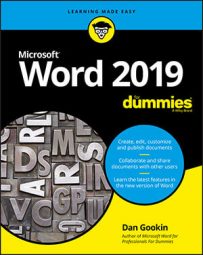Bye-Bye, Start Screen
You might prefer to see a blank page when you start Word, not a screen full of options. The Word Start screen can easily be disabled. Follow these blessed steps:- Click the File tab.
- Choose Options. The Word Options dialog box appears with the General category chosen for you.
- Remove the check mark by the item Show the Start Screen When This Application Starts. This item is found in the Start-Up Options section.
- Click OK.
Restore the Traditional Open and Save Dialog Boxes
When you use the Ctrl+O or Ctrl+S commands, you’re thrust into the Open or Save As screens, respectively. These screens are referred to as the Backstage, and are one more annoying step in a process that eventually ends up at the traditional Open and Save dialog boxes.To dismiss the Backstage, follow these steps:
- Click the File tab and choose Options to bring up the Word Options dialog box.
- Choose the Save category on the left side of the dialog box.
- Place a check by the item Don’t Show the Backstage When Opening or Saving Files. This item is found in the Save Documents section.
- Click OK.
One advantage of the Backstage is that it does show recent files. It also lets you pin popular files so that they’re easy to find.
Turn Off the Mini Toolbar
When you use the mouse to select text, Word displays the mini toolbar, which looks like the figure. You may find its assortment of commands useful, or you may just want to set the thing on fire. If the latter, you can disable the mini toolbar by following these steps:- Click the File tab and choose Options. The General category is automatically chosen for you.
- Remove the check mark by the item Show Mini Toolbar on Selection. This item is located below the heading User Interface Options. It’s right up top.
- Click OK.
 The mini toolbar.
The mini toolbar.If you would rather not eternally banish the mini toolbar, note that it hides itself whenever you move the mouse pointer beyond the selected chunk of text.
Select Text by Letter
When you’re selecting more than a single word, the mouse grabs text a full word at a time. If you want Word to select text by characters rather than by words, follow these steps:- Click the File tab and choose Options to display the Word Options dialog box.
- Choose Advanced.
- Remove the check mark by the item labeled When Selecting Automatically Select Entire Word. This item is located below the Editing Options heading.
- Click OK.
You can still select text a word at a time: Double-click to select a word, but keep the mouse button down. As you drag, text is selected one word at a time.
Disable Click-and-Type
Click-and-Type is that feature where you can click anywhere in a document and start typing. The feature is evident by an odd-looking mouse pointer and strange lines around the insertion pointer in your text. To mercifully disable this Click-and-Type, follow these steps:- Click the File tab menu and choose Options. The Word Options dialog box appears.
- Choose Advanced.
- Remove the check mark by Enable Click and Type. This option is located below the Editing Options heading.
- Click the OK button.
Paste Plain Text Only
When you copy and paste text from one part of a document to another, the format is retained. Similarly, the format is kept when you copy and paste text from another document. If you like, you can direct Word to paste only plain text or attempt to paste formatted text. Heed these directions:- Click the File tab and choose Options.
- In the Word Options dialog box, choose Advanced. Four text-pasting options are listed under the Cut, Copy, and Paste heading. These options tell you how text is pasted based on its source.
- Change the paste settings according to how you prefer text to be pasted. In most cases, keeping the source formatting is what you want. You might prefer to choose the option Keep Text Only because it doesn’t mess up your document’s formatting.
- Click OK.
You can use the Paste Special command at any time to override your decision: Click the Home tab and, in the Clipboard group, click the Paste button to choose whether or not to keep the formats.
Disable AutoFormat Features (×4)
The final four items worthy of deactivation fall under the domain of the AutoCorrect dialog box. Specifically, the overeager AutoFormat feature, which aggressively interrupts your writing with jarring suggestions you probably don’t want to see.Start your disabling binge by summoning the AutoCorrect dialog box. Follow these steps:
- Click the File tab and choose Options.
- In the Word Options dialog box, click the Proofing category.
- Click the AutoCorrect Options button. The AutoCorrect dialog box shows up.
- Click the AutoFormat as You Type tab. You’ve arrived.
- Automatic Bulleted Lists: This feature assumes that whenever you start a paragraph with an asterisk (*) you really want a bulleted list, so it changes the format.
- Automatic Numbered Lists: This feature works like Automatic Bullet Lists, but does the same annoying thing for any paragraph you start numbering.
- Border Lines: Type three dashes in a row and you see this feature activated. Use the Borders paragraph format instead.
- Format Beginning of List Item Like the One Before It: This feature assumes that just because the first word of the preceding paragraph is in bold or italics that you desire all other paragraphs to start that way as well.

